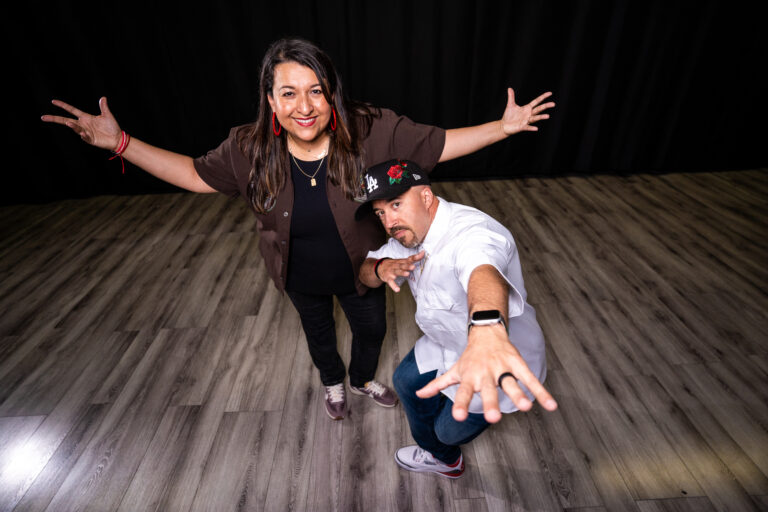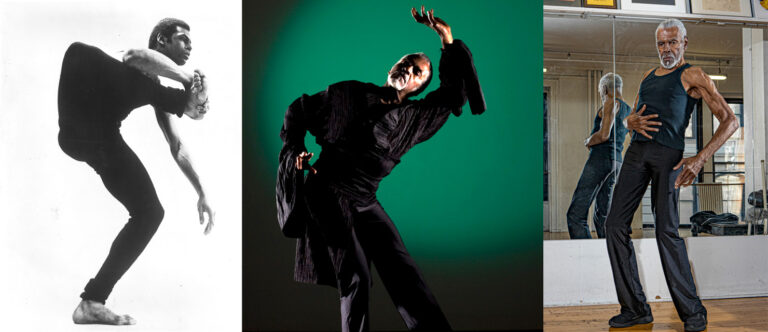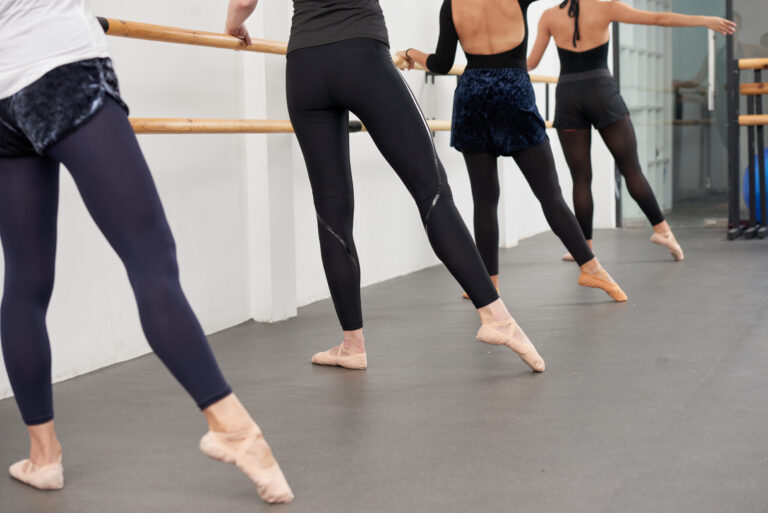What do you do when a student in a wheelchair rolls through the studio doorway into your Ballet I class? Many dancers—teachers and students alike—simply do not account for this possibility. Let’s admit that the word “dancer” in the popular imagination still, despite slowly increasing diversity, evokes the image of a ballerina, long and lean and delicately balanced on pointe in arabesque. Long and lean, and able-bodied. That a dancer could use a wheelchair or crutches in the studio and onstage doesn’t occur to many of us, despite the visibility of physically integrated companies such as AXIS Dance Company. So, when a wheelchair dancer shows up for class, many of us don’t know what to do.
Take Kitty Lunn’s experience when she rolled into a ballet class in her wheelchair at a well-known studio in New York City more than 25 years ago. Lunn, director of Infinity Dance Theater, had been a dancer as a child and teenager, but an accident in 1987 had broken her back and left her a wheelchair user. The call of dance was too strong for her to ignore, and after working intensively with a physical therapist for several years, she decided to return to class. Her welcome was less than enthusiastic.
“I was told in no uncertain terms that if people complained, I’d have to leave,” she says. Nonetheless, she stayed, and she has continued to take ballet, modern and jazz classes, in addition to founding and directing her own physically integrated dance company. At first, depending on the instructor, Lunn was sometimes ignored or simply tolerated in class, and sometimes welcomed and worked with individually. Regardless, she took her training into her own hands, and if one teacher did not want her in class, she switched to another.
Facilitating a physically integrated dance class, where disabled and “typically bodied” students work alongside each other, might be outside many teachers’ experiences, but according to several dance educators we spoke with, an open mind and a willingness to ask, learn and adjust can enable students and teachers alike to expand their understanding of who dancers are and how we teach, learn and perform dance.
Get at the Core
“… when you get down to some practical issues, it makes sense to divide students up and work on particular skill sets (i.e. wheelchair skills).”
—Merry Lynn Morris
Dance techniques and styles embody certain core values, such as line in ballet, or weight in modern, and these values can be instilled in any body. Ana Rubinstein, a dance teacher at the Manhattan School for Children, runs a physically integrated classroom. “When I sit down to think about teaching ballet, I have to think deeply about the aesthetic core,” she says. “What are the most important elements of this form? If ballet is about line and extension and smooth transitions between shapes and storytelling, that’s what I will focus on. If I’m teaching African dance, it’s really about that relationship to the ground, the energy of fast-firing movement, bouncing, call-and-response.”
Additionally, exercises can be distilled to their essence and transposed for different bodies. Bonnie Schlachte, owner and director of Ballet For All Kids, offers training for teachers interested in working with disabled students. “I tell my teachers, ‘Sit in a chair, and do the tendu yourself. What muscles are you working? Maybe you’re just working on adduction.'” Then consider how to apply adduction to any body part—arms, fingers, feet.
Lunn elaborates on how this distillation worked for her. In that first ballet class she attended in her wheelchair, “as soon as the music started playing, I had no idea how I was going to do this, but my gut instinct was to start transposing the movement. I hung out in the back of the class and just started figuring it out,” she says. At home, “I went through every ballet exercise I could think of, considering, Why is it done that way, and how can I make it work for my body? I realized for me, the process remained remarkably the same in terms of the pliés I constructed, using my arms as my legs, turning out from the shoulder as you would turn out the leg from the hip. It just seemed so natural for me. I’m doing the same thing differently, for the same reasons.”
Maintain the Form’s Integrity
Schlachte grew up dancing, majored in psychology, and after college began working with disabled adults. After the birth of her daughter, who is typically bodied, she wondered what she would do if her daughter had a disability and wanted to take ballet. She founded Ballet For All Kids as a way of teaching classical ballet technique inclusively. She wanted to make sure the technical training she offered wasn’t “dumbed down,” she says, because “you can’t get the benefits of a classical ballet education unless you’re teaching classical ballet. Everything that I do at Ballet For All Kids is based on ballet technique that can be taught at any studio, anywhere.”
Schlachte teaches a range of disabled and typically bodied students, and she maintains high standards for everyone. “Keep expectations high,” she says. “You don’t ever want to treat someone with a disability any differently than you would your other kids. The more I expect from them, they always rise to the challenge.” Along with high standards, teachers can help disabled students rise to the challenge just like they do typical students—by providing them the tools they need to succeed.
Partnership
Several educators emphasized the importance of team-teaching in physically integrated classes, with both a disabled and a typical instructor. Lunn notes, “If you are going to have an inclusive class, it’s really important to be team-teaching with a nondisabled and a disabled teacher so that both sets of kids can see a model.” In introducing her own students to mainstream classes, says Lunn, she herself will accompany them when possible and demonstrate.
In addition to team-teaching when possible, the presence of aides in the studio makes a critical difference, whether they are advanced dancers assisting students or aides who accompany disabled students throughout their day. Disabled students may need more individualized attention that accommodates the nature of their particular disability, and one teacher cannot be everywhere. Aides facilitate safety for their charges, which is often brought up as a concern when disabled students want to dance.
Merry Lynn Morris, assistant program director at University of South Florida’s dance program, works with REVolutions Dance. She teaches integrated classes and choreographs works for the company. “I think the fully inclusive spirit and mind-set is the way to go, but when you get down to some practical issues, it makes sense to divide students up and work on particular skill sets (i.e. wheelchair skills). We do have assistants in the class, which makes the flow of the class manageable.”
Teachers can also approach students as partners in their own learning—which makes for sound pedagogy, regardless of ability. Schlachte suggests a one-on-one meeting with prospective students and their parents or caregivers. Have the student and parents come and watch a class; to build trust, spend time with the student before they join class. “Find out who this kid is, and what makes them tick,” she says. “If you’re going to work with a kid in a wheelchair, for example, you really want to make sure you’re focusing on their strengths. Maybe they can’t move their legs as much, but they can sit up really tall in the chair and really focus on their arms.” It comes down to offering “a lot of individualized attention within a structure that’s the same for everybody,” Schlachte adds. “Teachers need to be patient.”
Normalizing
Individualized attention, however, does not mean highlighting students’ differences. Schlachte emphasizes the importance of normalizing the presence of disabled students in the studio. Before a new student joins the class, she says, “prepare your other students. ‘These students are the same as you.’ Introduce them like you would any kid, with no condescension: ‘So-and-so is in a wheelchair, and she’s still here to dance.'”
Connie Michael, associate dean at University of the Arts, says: “When we do accept a student who’s different, we must be very careful not to isolate within a studio. That could happen on so many levels. That’s the risk, we have to really pay attention to isolation.”
To combat such isolation, Rubinstein incorporates exercises that address particular students’ needs into the entire class. For example, “if a student needs vestibular stimulation, I will incorporate that into the warm-up for everyone,” she says. “If there’s a kid who needs assistance to work across the floor with a physical therapist, then I will have everyone work across the floor in some kind of partnership.”
Roadblocks
This may all sound like a lot of work for teachers unaccustomed to working with disabled students.
As well, Rubinstein says, “It’s really easy for people new to this field to focus on what children are not able to do, as opposed to what they are able to do. It takes a lot of time, collaboration, observation and relationship-building to discern what’s important to a child and take them to their next level.” Teachers may not feel they have the time or the context to do this work. Other concerns are more practical. Michael says, “In America, we tend to get litigious right away. People ask, ‘Do you have insurance? What happens if somebody gets hurt?’ People tend to put up roadblocks first instead of looking at the possibilities.”
But, she adds, “People get hurt in dance classes all the time.” Any responsible teacher, for any group of students, should “provide a pedagogy that minimizes pathways to injury.” There’s no guarantee, of course, that students will not get hurt, and disabled students (with their caregivers, when appropriate), must understand this just as any other students do.
Paving the Way
An openness to allowing disabled students to participate is not enough. “There’s nothing worse than a teacher who agrees to include disabled kids but isn’t prepared” says Schlachte. Preparation, on the part of both the teacher and the student, is key.
“Mainstreaming by itself is not always empowering,” says Rubinstein. Integrating disabled and typically abled students in class means actually thinking it through, she says, as opposed to just opening the door to disabled students and saying, “Good luck.”
But when teachers and students are prepared and open, dance can work its particular transformative magic. All students—disabled and typically bodied—learn how to take up space, says Rubinstein, and how to use their bodies as tools for problem-solving. All students gain a deep appreciation of dance and learn to understand different movement qualities and stretch themselves past their limits.
“If you don’t present a program where disabled kids can see themselves as part of a larger dance community, there’s no way they’re ever going to see themselves as dancers,” says Rubinstein. “Maybe even more important, it’s changing the culture of the able-bodied kids in the room: understanding the power and strength of their peers who are disabled.” And Lunn says, “I believe if more experienced disabled dancers put themselves into mainstream classes, then it will change. The more we stay segregated, the less we will become inclusive.”
Teachers, too, can grow their own practice and expand their understanding of what dance can be by integrating disabled students into their classes. Morris says, “I love the way teaching in this context pushes me creatively and makes me think differently about definitions of dance and dance training. It’s an opportunity to innovate.” Michael completed teacher training with the DanceAbility program. “You’re finding incredible ways of moving that you’ve never imagined,” she says. “Different movements come out of you, and you don’t even know where they came from. The expressivity of your own body really blossoms, not to mention being in a community with some really remarkable people.” DT
Lea Marshall is associate chair of Virginia Commonwealth University Department of Dance & Choreography in Richmond, Virginia.
Teacher Training Programs in Physically Integrated Dance
• Axis Dance Company Teacher Trainings
• Dance Ability Teacher Certification
• Full Radius Dance
• Infinity Dance Theater
Success Story
One of Bonnie Schlachte’s longtime Ballet For All Kids students has peripheral neuropathy. “The pathways from her brain to her nerves don’t always tell her the right things. She can’t always feel her feet. She’s been with me seven years and was supposed to be in a wheelchair by now. When she first started dancing with me, she had to have someone hold her up when she walked; her ankles would give out all the time. Last recital, she did a solo, walked onstage all by herself. It’s been remarkable to see her blossom. Now she’s going to college, by herself, not in a wheelchair. A lot of it is physical therapy, but a lot of it is the ballet.”
“The more I expect from them, they always rise to the challenge.” —Bonnie Schlachte




